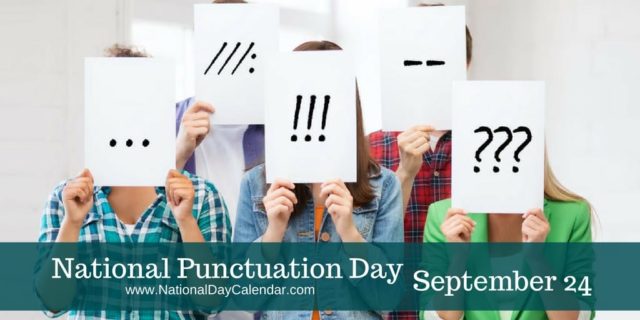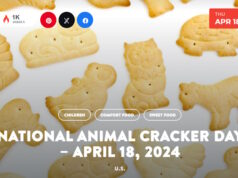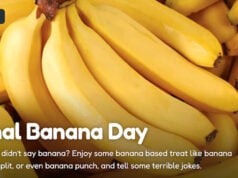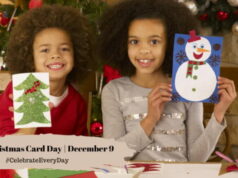
A period, a comma, a semicolon, a question mark and an exclamation point are examples of some of the punctuation used in writing to separate sentences and their elements and to clarify meaning. National Punctuation Day commemorates these and all punctuation annually on September 24th.
Across the country, National Punctuation Day events test skill, educate and even poke fun at some of those embarrassing errors.
- Auburn Elementary School of Auburn, MI celebrates National Punctuation Day annually.
- The founder of The National Punctuation Day sends out a challenge every year. Visit Jeff Rubin’s website to enter the contest.
- Punctuation Day was established by Jeff Rubin, founder of the day and organizer of www.nationalpunctuationday.com. Punctuation can be tricky for some people, those who struggle to know when it’s appropriate to use a colon, or a set of brackets, or even an ellipsis.
- # has a name you’d never guess…Depending on when you were born, you probably know the # symbol as either a pound sign, number sign, or for the Twitter junkies among us, a hashtag. Turns out, none of those names are right: According to an engineer at Bell Labs (formerly part of AT&T), which made the symbol mainstream via its touch-tone telephones in 1968, that little hex is called an octothorpe.
- @ has hilarious names around the world…A Dutchman calls it the monkey’s tail, an Israeli insists it’s a strudel. They aren’t bantering about some new simian-themed bakery; they’re just describing the @. Though shorthand use of the @ dates back to the 16th century, it took English speakers a remarkably long time to settle on a name. Today, we know it as the “at mark” or “commercial at” and are accustomed to seeing it in e-mail addresses. Meanwhile, the rest of the world was inventing brilliant descriptors, like the “little dog” (Russian), the “small snail” (Italian), and the straight-up “crazy A” (Bosnian).
- Though the exclamation point has helped express strong sentiments on paper since the 15th century, this upstanding punctuation mark didn’t get its own dedicated typewriter key until the 1970s. Before then, typists who wanted to use interjections in their work had to type a period, then backspace and type an apostrophe atop it. Secretarial manuals of the ’50s called this Franken-symbol a bang—not to be confused with an interrobang, which is an exclamation point overlapping with a question mark to indicate incredulity.
- For some deranged reason, they got rid of one of the most useful symbols ever created: the interrobang. It’s even fun to say. It’s a question mark superimposed over an exclamation point, which on a modern keyboard is typed either ?! or !?. Obviously, it’s intended to represent a question asked excitedly. You can’t beat a punctuation mark that’s simultaneously a portmanteau and onomatopoeia. If you agree, go like the interrobang Facebook page.
- The oh-so-misunderstood comma has an equally treacherous-sounding history. It comes from the Greek “komma,” which refers to something that’s been cut off (i.e., a clause).
- Hyphens, en dashes and em dashes, oh my! Hyphens are just used to join words, but people tend to think they’re the only horizontal punctuation game in town, even substituting them for their longer counterparts (oh, the horror!). En dashes are slightly longer than hyphens. Actually, they’re the same width as the letter N, and they indicate that you’re trying to show range (10–12 pounds). The em dash is… wait for it… the same width as the letter M and is a totally legit punctuation mark, often subbing in for commas and parentheses when greater emphasis is required — like when you’re trying to make a point.
- An ellipsis, those three little dots you see in a row so often, is from the ancient Greek meaning “omission,” which is exactly how it’s typically used in journalism — to indicate that words the journalist doesn’t believe affect the meaning of the quote are being left out.
Sources:












